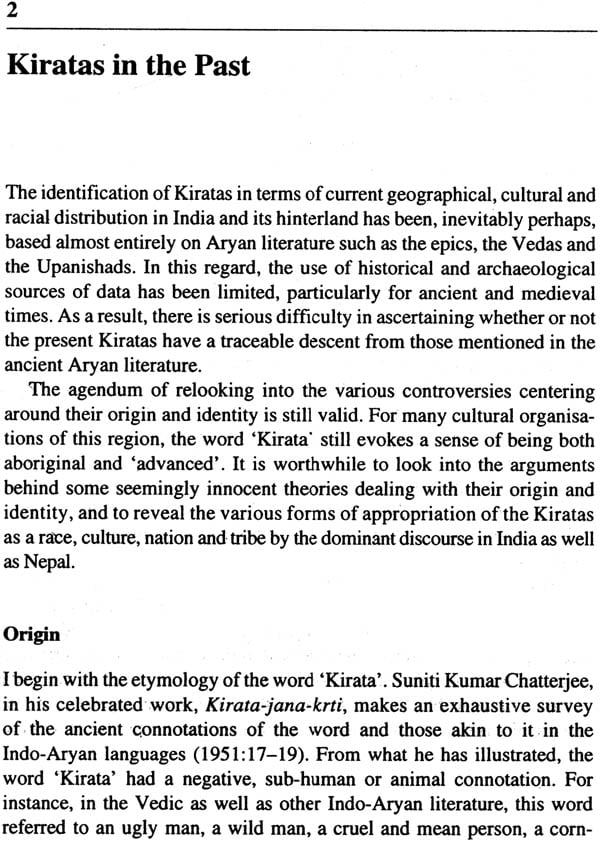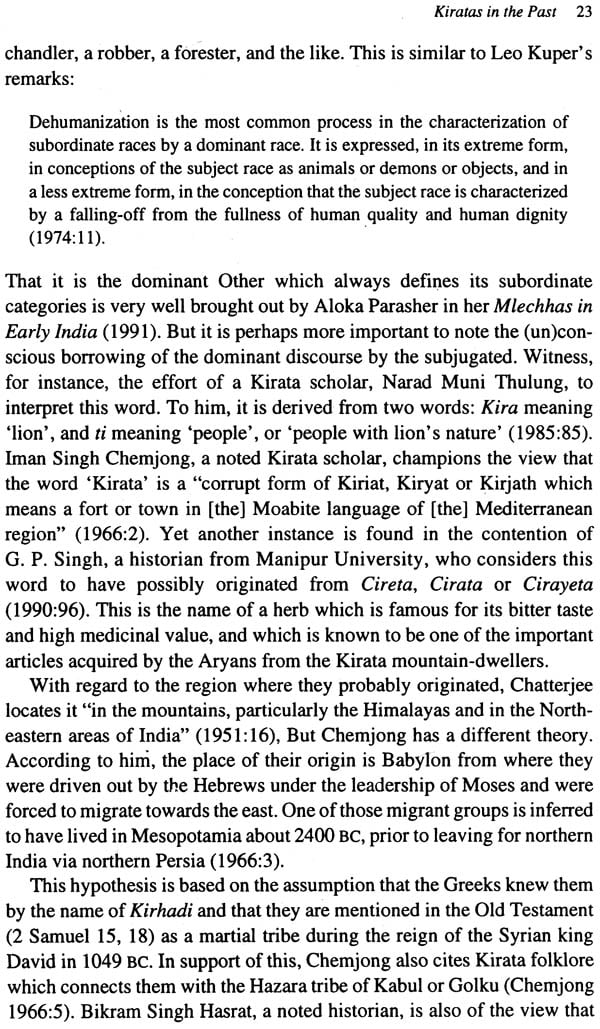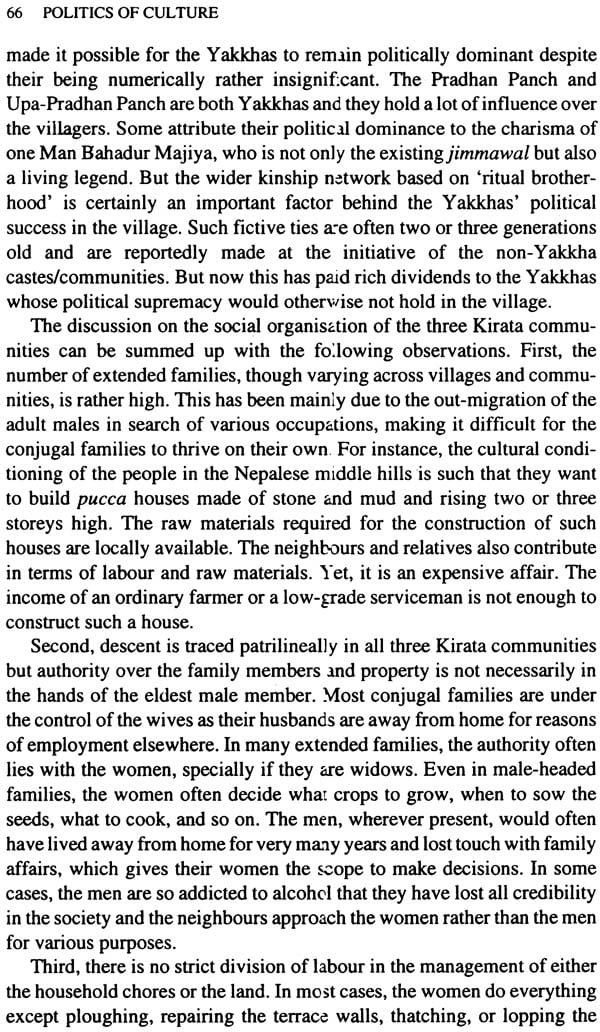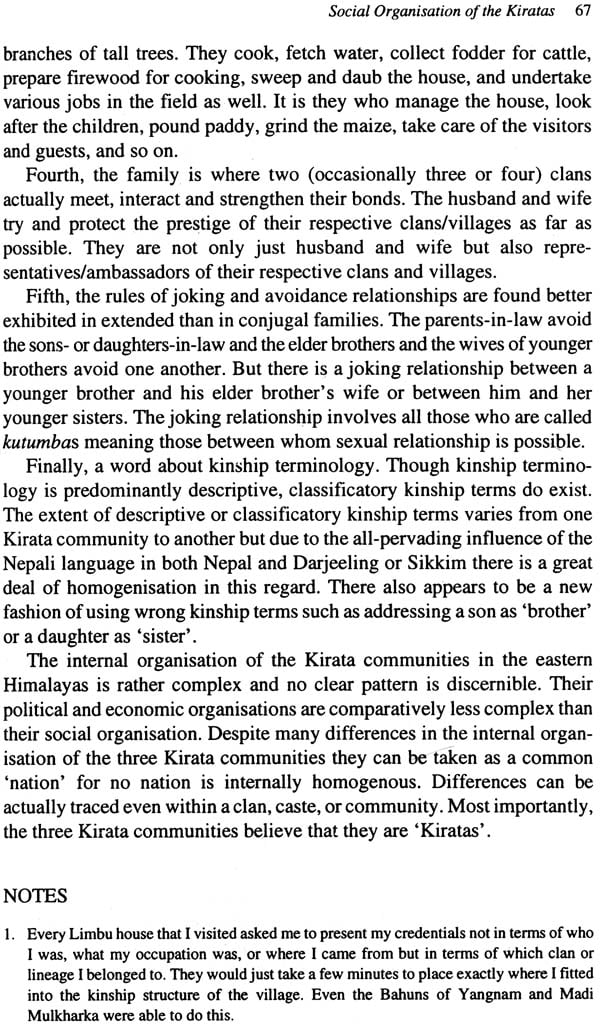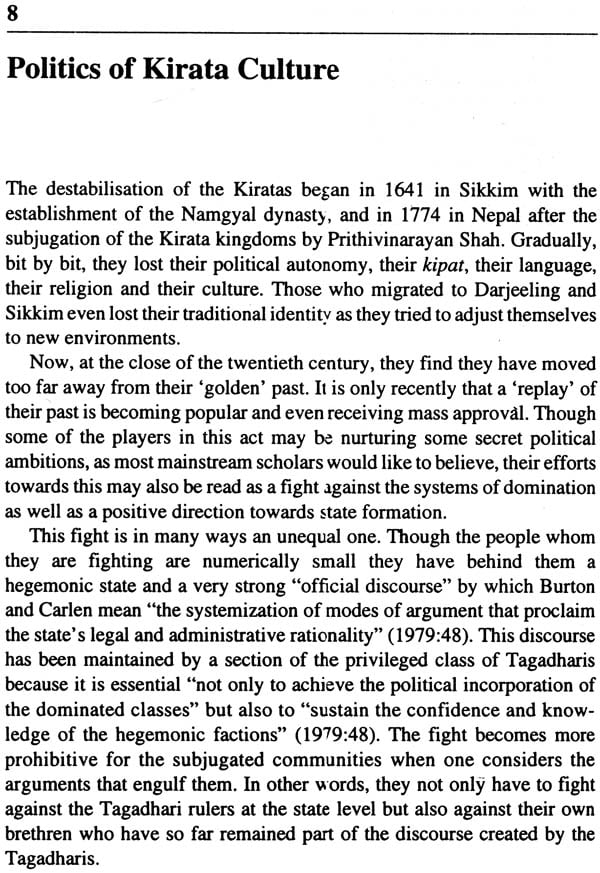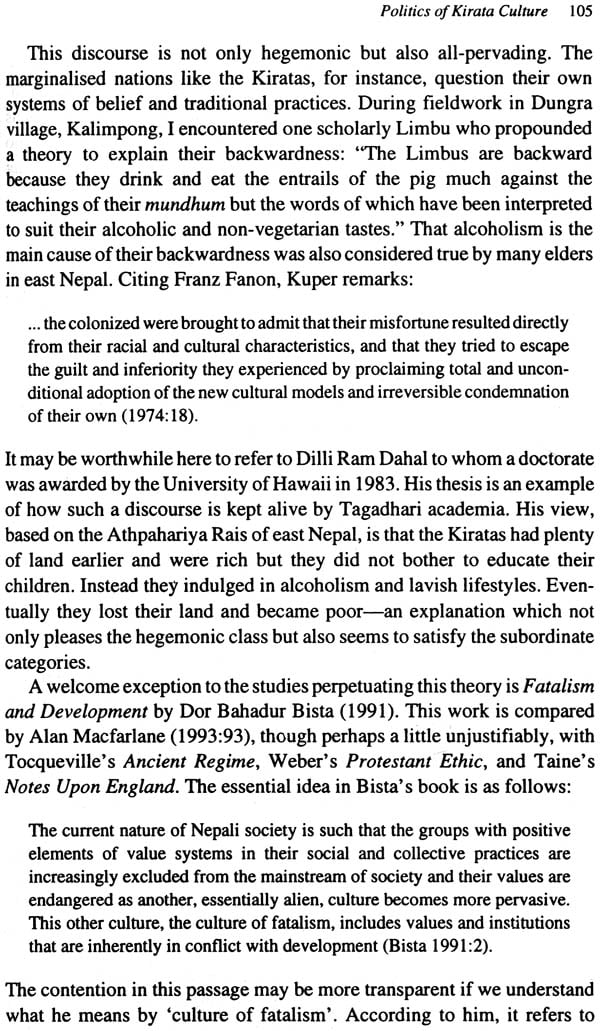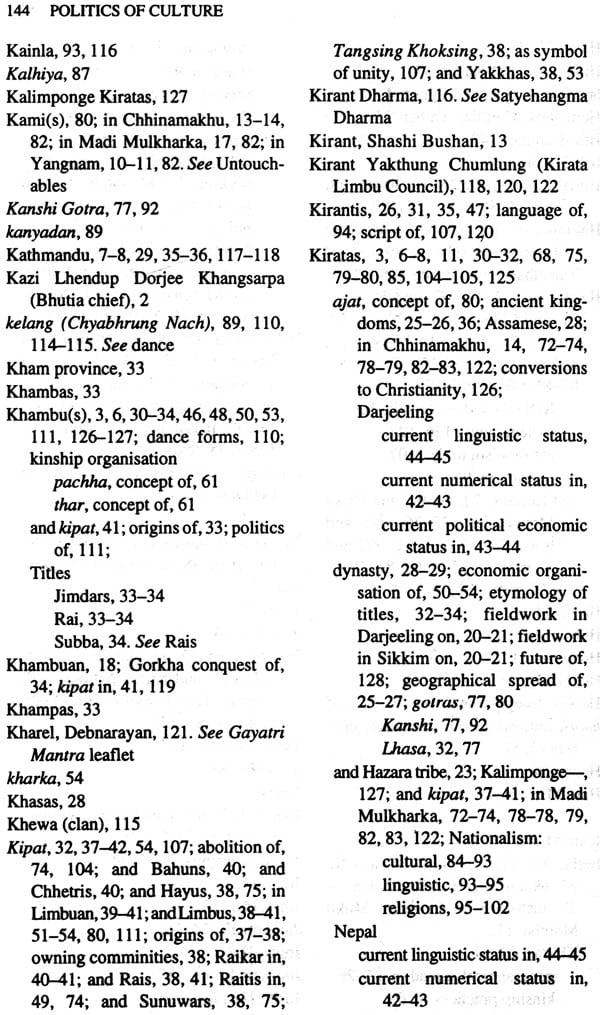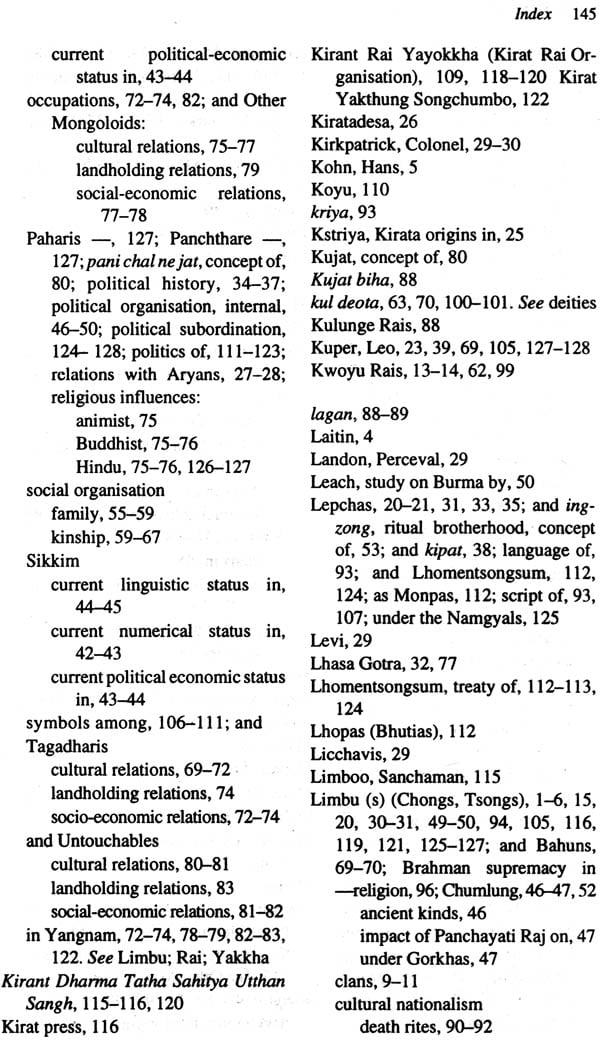
Politics of Culture (A Study of Three Kirata Communities in the Eastern Himalayas)
Book Specification
| Item Code: | NAF826 |
| Author: | T B Subba |
| Publisher: | Orient Longman Pvt. Ltd. |
| Language: | English |
| Edition: | 2001 |
| ISBN: | 9788125016939 |
| Pages: | 168 |
| Cover: | Paperback |
| Other Details | 8.5 inch X 5.5 inch |
| Weight | 190 gm |
Book Description
This book traces the cultural proximity and the similar destinies of three Kirata communities living in the eastern Himalayas-the Limbu, the Rai and the Yakkha. Spanning the last two hundred years, this book outlines the process of economic, lingistic, religious and cultural degeneration that the groups faced at the hands of the powerful Gorkhas in Nepal and the Namgyals in Sikkim, resulting in their becoming victims of state-formation in these two erstwhile Himalayan kingdoms.
The author reconstructs the story of these communities on the basis of historical as well as ethnographic data, and explains their need to reconstruct (imagine) today, an identity for themselves despite the time and cultural resources they have lost.
this incisive study of a region and of communities largely silenced through a lack of visibility in academic research, is an outcome of the work Professor Subba undertook as a Homi Bhabha Fellow.
Professor T B Subba is presently Head of the Department of Anthropology, North-Eastern Hill University (NEHU), Shillong. a Homi Bhaba Fellow from 1992 to 1994, his area of research is the eastern Himalayan region. he is a member of the Editorial Board of the Journal of Social Sciences and Humanities (Shillong), published by the North-Eastern Hill University, and a member of the Advisory Board of the Journal of Human Ecology (New Delhi).
The Problem
In the geographically contiguous areas of Darjeeling, Sikkim and Nepal there has recently been a mushrooming of organisations which seek to preserve and develop their indigenous culture, language and religion. More than a dozen such groups in Nepal have established their branches wherever their members live. Another half dozen have emerged in Sikkim. However, in Darjeeling, some of these associations date back to the beginning of this century while a few are fairly recent. Darjeeling became a part of India in the mid-nineteenth century and its relative political openness allowed such organisations to come up quite early. In contrast, the hereditary and theocratic rule in Sikkim and Nepal have opened up only very recently.
Despite an earlier emergence, most of Darjeeling's indigenous organisations have had little impact on the cultural and political history of the region. The living conditions in Darjeeling after it came under Bengal in 1866 were not conducive to their growth. The political and cultural pressures of a numerically dominant and educationally far 'superior' Bengali 'race' (see Smith 1993 for the concept) forced the various communities like the Gurung, Tamang, Mangar, Rai and Limbu to come under the umbrella of the Nepali or Gorkhali nation (nation meaning peoples here, not nation-state). Their respective identities had to be submerged in order to constitute a force strong enough to resist Bengali domination and ensure their common survival. Thus, they became a part of the Gorkhali or Nepali people and the Nepali language became their language as well. In the process, their own languages and scripts were pushed into oblivion, often unable to be revived due to inadequate numbers of speakers in a particular locality.
If such were the reasons for the various communities like the Limbu, Newar, Rai and Gurung to be deprived of their culture, language and religion in Darjeeling, the conditions in Sikkim were similar to those existing In Nepal. The Buddhist theocratic and hereditary rulers there did not allow such groups to come together nor did they recognise the cultural, linguistic and religions heterogeneity within the so-called Nepalis. To them, such communities were basically 'migrants' from Nepal, Hindus by religion and ‘troublesome as neighbours'.
This perception of the Bhutia rulers in Sikkim was primarily shaped by their long historical Interaction with the Gorkhas. Such interactions were characterised by internecine wars which forced the Bhutias to gradually shift their capital from the west to the east of the kingdom. With little social Involvement with the Nepalis even after 1890, which marked the end of the Gorkha-Sikkim wars, they remained oblivious of the cultural and other kinds of heterogeneity within the Nepalis. This happened due to ecological as well as political reasons. The Bhutias lived in the higher elevations and were concentrated in the present northern district of Sikkim, entry into which was politically forbidden to the Nepalis. However, they made one exception in this regard-to recognise the Limbus or Chongs as a separate community from the rest of the Nepalis and extend some privileges to them.
In Nepal, the Gorkha rulers were acutely aware of the cultural, linguistic and other differences across communities but they were not officially recognised as separate nationalities. They were essentially treated as subjugated or conquered peoples who needed to be brought under the Nepali nation. Prithivinarayan Shah, the Gorkha king who was responsible for politically demarcating the present boundaries of Nepal in the early 1770s, had metaphorically set the official attitude towards such people when he described Nepal as 'a garden of four varnas and thirty-six jats'. The different peoples were, In other words, just different flowers in a garden, or 'castes' which are organically related to each other. This analogy has great symbolic value for the ruling elite and most mainstream scholars In Nepal even today represent the official attitude towards the various nationalities there.
The situation, however, changed when Sikkim became a part of India In 1975, Darjeeling suspended the Gorkhaland Movement and settled for the Darjeeling Gorkha Hill Council in 1988, and Nepal yielded to democratic forces in 1990. While the background of the national leaders in NepaI is still largely the same, Sikkim was briefly ruled by a Bhutia Chief Minister (Kazi Lhendup Dorjee Khangsarpa) before it came under the rule of a Chhetri Chief Minister (Nar Bahadur Bhandari) in 1979 and remained so for about fifteen years. Darjeeling has a Tamang (Subhas Ghisingh) holding the post of the chairman of the Darjeeling Gorkha Hill Council. The Bhandari rule in Sikkim was, however, possible not only due to Nar Bahadur Bhandari's charisma, as some argue, but also to the synthesised Nepali nationalism developed there over a long period of time by the Bhutia rulers.
The United Nations declaration of 1993 as the Year of the Indigenous Peoples gave further impetus to the already changed political climate and brought a new lease of life to the marginalised and subjugated communities in the region. They began to organise themselves vigorously in search of lost identities.
The present situation is characterised by an active process of reinventing linkages not only within such classified groups like Limbu, Rai and Tamang but also at the level of cognate concepts like 'Kirata', 'Janajati' and 'Mongol'. The profile of various such organisations provided in Chapter 8 indicates that they are trying to recreate their culture, religion and language primarily at the former level. While the Tagadhari category representing the Bahun, Thakuri and Chhetri castes constitutes an objective entity, the essentialised Kirata, Janajati or Mongol identity is yet to evolve fully as its anti-thesis. The people designated as 'Kiratas' here are yet to crystallise their ideology and culture. They still seem to vacillate between the relatively single and simple delineations such as the Limbu or Khambu and the more compound and complex characterisations like Kirata, Janajati or Mongol.
Due to the changed situation, the historically marginalised communities are now seeking to challenge the hegemony of the Tagadharis (high castes like the Bahun, Thakuri and Chhetri) and are in the process of 'inventing' their national consciousness. There has begun, to borrow from Foucault, an 'insurrection of subjugated knowledges'. The 'subjugated know ledges', according to him, refer to "a whole set of know ledges that have been disqualified as inadequate to their task or insufficiently elaborated: naive know ledges, located low down on the hierarchy, beneath the required level of cognition or scientificity" (1980:82). This would not be possible without the changed political climate of the region. But it is desirable to understand why there is a sudden need to 'imagine' these nationalities.
Politics of Culture
The concept of 'culture' not only varies according to the aspects emphasised by various anthropologists but also according to the time it has passed through. There are endless-some already dated-debates over whether it is value-free or value-loaded, society-specific or universal, hierarchical or differential, process or structure, material or non-material, and so on. One also notices a shift in its focus on material artefacts to the more abstract, formal and conceptual aspects in the post 1950s (see Bauman 1973). Recent conceptualisations of culture, for instance, speak of it as a system of meanings, ideologies, unconscious structures.
Towards further elaboration of this concept, Laitin (1977) draws attention to the hegemonic nature of culture. According to him, the "[p]olitical elites in any society will act strategically and ideologically in the hope of defining and delimiting which strands of their society's culture should become dominant. Those who are successful in establishing a dominant cultural framework form a 'hegemonic bloc" (1977: 171). But since hegemony can only create a dominant subsystem and cannot "create a congruent and harmonious social system", he concludes that the "non- marginal affronts to the commonsensical order are inherent in all hegemonic structures" (1977:183).
Another aspect of culture that may be brought to bear on the discussion here is its use in what is called 'reconstructive ethnography'. Such an ethnography overlooks the social and historical conditioning of culture because it presupposes that the indigenous cultures succumb under the impact of 'civilisation' and exist as a category of 'traditional remains'. Such cultures are not only assumed to be 'static' but the people representing them are even branded as people without a culture (Devalle 1992:40).
Culture may perhaps be seen here as a symbolic system within which a group of people operate in order to perpetuate or fight against a ‘hegemony' which is defined as "the political forging-whether through coercion or elite bargaining-and institutionalization of a pattern of group activity in a state and the concurrent idealization of that schema into a dominant symbolic framework that reigns as common sense" (Laitin 1977: 183). In other words, culture is not an independent or isolated symbol in harmonious equilibrium with another culture but it is a system in constant conflict within and with other cultures for better appropriation of the available resources of a state. This should not, however, be con- strued to mean that there was no culture prior to the emergence of the state. It was there, in hierarchical relationship with other cultures, but it was then governed by traditions. The hierarchy assumed the relation- ships of superordination and subordination after the emergence of the state.
Another concept which is politically akin to the concept of culture is 'nationalism' which, according to Gellner, is "primarily a political principle, which holds that the political and the national unit should be congruent” (1987:1). P.H. van der Plank makes it more explicit when he defines it as "an ideology consisting of values, symbols, norms and expectations, living in a social collectivity (group) and based on belief in a common descent and, as a consequence, a common destiny, strong enough to desire to maintain, strengthen or create a formally and legally organized society" (1975:9).
One of the problems with this concept IS that such an ‘Ideology’ may be confined to a nation or, more frequently, extended to a nation-state (Kohn 1968:63). When it is used in the former sense it is often qualified as 'ethno-nationalism', 'proto-nationalism', 'sub-nationalism, fissiparous-nationalism', 'mini-nationalism', and what have you.
Nationalism, as it is understood by Louis L. Snyder, .is: “A condition of mind, feeling, or sentiment of a group of people living in a well-defined geographic area, speaking a common language, possessing a literature in which their aspirations are expressed, attached to common traditions and customs, venerating their own heroes, and, in some cases, having the same religion” (1982: xv). The problem here is that there are many nations like the Jewish and the Palestinian which cannot be fitted into this.
The boundaries of a culture or nation and a nation-state seldom overlap but both involve a similar process of nation-building. This process invariably involves homogenisation of cultural and ideological values within a group or a number of groups, which means Imposition of the Ideology, norms and values of the hegemonic group on the marginal groups. While the Limbus (or the Rais) resist cultural or linguistic standardisation by the Tagadharis, they also carry out the same process within their own groups. What is resisted at the level of the nation-state is thus perpetrated at the level of a culture or nation.
The appeal of culture in all such nation-building processes is unquestionable. Spencer has illustrated this well with his study of Sinhala, culture and nationalism (1990). Gellner has gone even further to define ‘nation’ in terms of culture though he is equally aware of the 'voluntaristic’ aspect of the concept of nation. According to him, “Two men are of the same nation if and only if they share the same culture, where culture in turn means a system of ideas and signs and associations and ways of behaving and communicating" (1987:7).
The relationship between culture and nationalism has assumed renewed significance after the emergence of the concept of ‘national culture'. Its relationship with the nationalist ideology is, according to Richard Fox, “contingent and processual: the creation of nationalist ideologies anticipates a larger project, the forming or reforming of a national culture (1990:4). He further writes: "A national culture starts out as a nationalist Ideology, that is, a consciousness or perception of what the nation is or should be, which then may gain public meaning and be put into action. Usually there are several co-existing and even contradictory perceptions, which constitute competitive nationalist ideologies"(1990:4).
It is here that Benedict Anderson's phrase 'imagined community' (1991) becomes contextual. Like national culture, the imagined community is not given but consciously created. The word ‘imagined’ may be, perhaps justifiably, equated with Hobsbawm’s ‘invention’ and defined operationally as a ‘construction’. In this sense, a nation is ‘imagined’ because, as Anderson writes, "the members of even the smallest nation will never know most of their fellow-members, meet them, or even hear of them, yet 10 the minds of each lives the image of their communion" (1991 :6). He goes on to explain the nationalist upsurges in modern times as functions of "cultural roots" rather than "self-consciously-held political ideologies (1991: 12). The Importance of culture in relation to nationalism has also been recently illustrated with the case of the Oromo speakers in Africa (see Baxter 1993).
However, the link between culture and nationalism has assumed added significance particulary because the state has grown conceptually incompatible with culture (Nandy 1997) and it has virtually turned out to be the patron of the dominant culture. It is such a failure of the state that has been primarily responsible for the subjugated cultures redefining their cultural and national boundaries.
The present study is an attempt to establish the relationship between the state or the surrogate community and the politics of marginalised cultures or nations on the basis of historical as well as ethnographic data on three Kirata communities living in the eastern Himalayas-the Limbu, Khambu or Rai, and the Yakkha.
The Fieldwork and the Field Fieldwork is considered indispensable in any anthropological study that deals with contemporary society. The early fieldwork tradition established by anthropologists like Malinowski and Radcliffe-Brown is still taken as the Ideal, particularly in terms of the length of stay and acquisition of the native languages. Many European and American universities are trying to live up to this ideal even today. But much has changed in this tradition after the 1950s, particularly in studies of the post-colonial world. This anthropology operates mostly within a familiar universe though the exact language/dialect and place may not have been known before. The norms and values are not as different as they were between the European anthropologists and their Orients.
In India, post-colonial anthropology cannot be considered to be different from the colonial. The old boundaries between Subject and Object are redrawn within the country. Only certain categories of people such as the tribals, minorities or frontier peoples are taken as Objects and certain others take on the role of Subjects (though they themselves may have been Objects for the European or American anthropologists). The language and mind-set of the Subjects in terms of ethnographic representation are much the same as in colonial anthropology (Po'dar and Subba, 1991).
Where do I place my study of the Kiratas in such a tradition? I belong to one of the Kirata communities dealt with here - the Limbu - and have a distant Yakkha matrilineage as well. I was trained in an ethnographic tradition which was largely colonial but I have felt a strong sense of dissatisfaction with it. I feel dishonest when I write 'they' when I refer to my own community. I have lived and grown up with many of them. Will my research be branded as 'unscientific' or 'biased' if I write 'we'? Do I have to refer to my own people as 'they'? I do not seem to have much of a choice.
The selection of field sites for this study was governed by my 'subconscious mind', shaped by my conviction that the villages should be representative. But I could not afford to study more than three villages, one each for the three Kirata communities. My teaching and administrative responsibilities would not allow time for fieldwork outside of vacations and semester breaks.
I discussed the objectives of my study and the villages where I could possibly conduct my fieldwork with knowledgeable persons in Kath- mandu and Kalimpong. I soon had an exhaustive list of the districts and villages. Deciding on the Sankhuwa Sabha and Bhojpur districts to study the Yakkhas and Rais respectively was rather easy as only one or two persons had suggested otherwise. But in the case of the Limbus, the Panchthar district was decided upon after due deliberation over the merits of the Terethum district in east Nepal and the West district of Sikkim, each promising to be more representative of the Limbu culture and society than the other. But, since I had already done my doctoral research in Sikkim, I decided to work in Nepal for this study. Between May 1992 and January 1993, I undertook reconnaissance visits to the three districts chosen and finally settled on Yangnam village in Panchthar district, Madi Mulkharka in Sankhuwa Sabha district, and Chhinamakhu in Bhojpur district as the best possible sites for my fieldwork.
During this period, I spent some time in Kathmandu, working in various libraries and interviewing scholars and Kirata leaders. I also went to Darjeeling and Sikkim to do similar work. A village in east Nepal often extends over a whole mountain and walking from one end to the other, vertically or horizontally, may take about half a day or more. In terms of geographical area it may extend between fifty and a hundred square kilometres and comprise about 800 to 1200 households. Each ward is often as big as a whole village in Darjeeling and Sikkim. Even the altitude range of a village in east Nepal is at least 1000 metres whereas it is only about 300 metres in Darjeeling and Sikkim. Despite the vastness and an apparent lack of compactness, villagers in Nepal can count and identify almost every household in their village. Almost every educated male head of a household is able to map out clans and lineages in the entire village.
For these reasons, the strategy of fieldwork in east Nepal villages had to be different from that in Darjeeling and Sikkim. Merely taking the census of household members, livestock and land for about a thousand households, spread over at least fifty square kilometres, and with an altitude range of about 1000 metres would have taken at least six months. Time was at a premium and I had, therefore, to be content with scaling down the work. I made a list of the various social groups in each village and simultaneously collected information on the approximate number of households as well as their distribution. On the basis of this list, I made a stratified random sampling of about ten per cent of the households which I visited and collected census data as well as information on their culture and nationalism.
The Field Sites
Yangnam: The village of Yangnam is located in the Panchthar district of east Nepal. The nearest urban centre is Fidim, the headquarters of this district, which is about twenty kilometres away. It is about a six to eight hours' walk from Fidim to Yangnam though many young men of the village can reportedly reach Fidim and return to Yangnam on the same day. Hiley is another town where the villagers of the northern fringe buy their necessities but this town is inaccessible during the rainy season due to landslides and flooding rivers.
Yangnam is bounded on the north by the Hewa khola (khola=nver), on the east by the Papungden khola, and on the south and west by the Khong khola. Thus, it is surrounded by rivers which are almost totally dry in winter but difficult to cross in summer. There is a concrete bridge constructed recently over the Hewa and there are temporary bridges of logs and bamboo over other streams. The village is divided horizontally by an arterial road which is about five feet Wide whereas other Village roads are rather narrow and not well maintained.
The altitude of this village ranges approximately from 610 metres at Hewa khola to about 2200 metres at Akashe hamlet. Beyond this altitude extend uninhabited areas which are used only for grazing in summer. The temperature varies from 0 to about 27 degrees centrigrade and the Village receives adequate rainfall. Except for some hamlets in the eastern part, the village receives adequate sunshine too.
. . There is one Madhyamik Vidyalaya (upto Class X), nine primary schools, two temples, a health post, an agriculture centre, a veterinary centre, the village post office, the Gaon Vikas Samiti building and the cooperative office. Khalangatar hamlet, where most of these are concentrated, looks like a semi-urban settlement. It also has general stores and tailoring shops. The ruins of an ancient fort, which was once a royal outpost, is also visible near the Madhyamik Vidyalaya.
The number of households in the village is not known exactly. My own estimate of the total is 873, of which I covered 112 households. Table I shows the distribution of households over the various Limbu clans and other castes/communities in the village.
| List of Maps and Tables | vii | |
| Acknowledgements | xiii | |
| 1 | Introduction | 1 |
| The Problem | 1 | |
| Politics of Culture | 3 | |
| The Fieldwork and the Field | 6 | |
| 2 | Kiratas in the Past | 22 |
| Origin | 22 | |
| Geographical Spread | 25 | |
| Relationship with the Aryans | 27 | |
| Kirata Dynasty | 28 | |
| 3 | Delineation of the Kirata World | 30 |
| The People | 30 | |
| History | 32 | |
| Present Status of the Kiratas | 42 | |
| 4 | Internal Organisation of the Kiratas | 46 |
| Political Organisation | 46 | |
| Economic Organisation | 50 | |
| 5 | Social Organisation of the Kiratas | 55 |
| The Family | 55 | |
| Kinship | 59 | |
| 6 | Kiratas an Other Social Categories | 68 |
| Kiratas and Tagadharis | 68 | |
| Kiratas and Other Mongoloids | 75 | |
| Kiratas and Untouchables | 79 | |
| 7 | Foundation of Kirata Nationalism | 84 |
| Culture | 84 | |
| Language | 93 | |
| Religion | 95 | |
| 8 | Politics of Kirata Culture | 104 |
| Symbols of Unity or Difference? | 106 | |
| Kirata Politics | 111 | |
| 9 | Whither Kiratas? | 124 |
| Bibliography | 129 | |
| Index | 138 |
